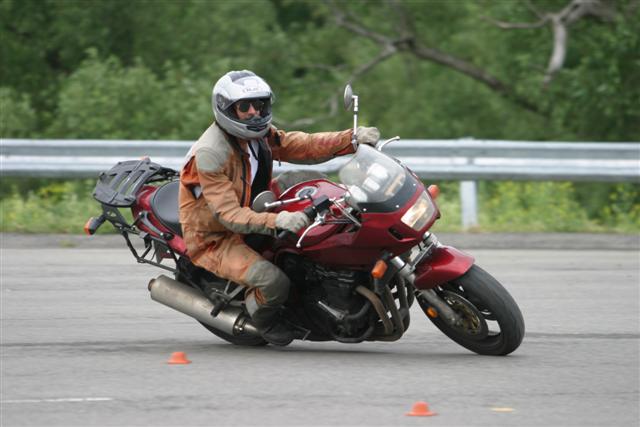Motorcycle Helmet Standards
One of the questions in the MSF's beginner rider class is about stickers that may be found on motorcycle helmets. The answer (in the USA) is that there must be a sticker from the US Department of Transportation, and there may be a sticker from the Snell Memorial Foundation. Many people have heard that a Snell sticker indicates a better helmet than a helmet with only a DOT certification. This is questionable. And it doesn't stop there, as the United Kingdom has its own certification standard, BSI, and the European Union has theirs, ECE. What does it all mean? And what do you look for?Consider the problem: A fast-moving head on a motorcyclist is about to become a slow-moving head. The rate of deceleration is the important factor, as rapid deceleration slams the brain around inside the skull, bruising it, and if it's rapid enough it can even tear the brain loose from the stem. The goal is to gently slow the head and brain to a stop. This is accomplished by the destruction of the helmet's outer and inner shells. If you drop an egg on a pillow rather than on a hard tile floor, the gradual yielding of the pillow slows the egg more gently than the unyielding floor, ideally slowly enough to avoid breaking it. Similarly, the yielding of the helmet's hard outer shell and styrofoam inner shell is intended to reduce the deceleration of the brain enough to be survivable.
The tradeoffs start with how much impact you expect the helmet to deal with. Simplistically, how fast will the head be going when it hits something solid? A helmet could be designed to protect against almost any impact specified in advance, just by increasing the amount of crushable material it contains. But there's a limit to how much styrofoam we're willing to surround our heads with, so there's a limit to how much impact our helmets can absorb and still cushion our heads adequately. The limit can be extended with better designs and better materials, but there's still a limit.
Other engineering decisions include what you expect the head to hit. A rounded concrete curb such as I grew up with in western Texas will affect a helmet and its contents differently than an impact with a sharp-edged granite curb such as are commonly used here in Massachusetts. How many times do you expect the helmet to hit? If there are multiple hits, will they be in the same place? Do we need to worry only about blunt impact, or is there a chance that some penetrating object may need to be dealt with, such as jagged parts from one's own motorcycle or another vehicle? The answers to such questions will probably best be found in crash investigation.
And it'd be bad if the helmet protected the head but strangled the wearer with the retention strap, or was so heavy that the neck was broken in the process of protecting the brain. Or so uncomfortable that it isn't worn.
So don't expect helmet testing to give unambiguous results. The British government's Safety Helmet Assessment and Rating Program — SHARP — results are widely consulted and you can find them here. For the geeks, a very interesting comparison of the various standards and the acceleration limits they allow is detailed here.
Lies, Damned Lies, and Statistics
There's a vocal subset of the motorcycling community which is against mandatory helmet use. I don't have a problem with that. I'm against helmet laws myself, though I wouldn't be caught dead without a modern full helmet. I am against people who spread misinformation — lies, that is — about helmets. To counter the lies, you need information. That information comes in the form of statistics. You have to be careful with statistics. But without statistics, you have only "war stories" of dubious truth and relevance. The best source of statistics on motorcycle crashes that I know of is the National Highway Transportation Safety Administration. This federal agency collects information on US highway crashes and publishes the data and conclusions drawn from the data. They are strongly in favor of mandatory helmet laws; that is, they know that it's safer to ride a motorcycle while wearing a helmet than to ride without a helmet, and conclude that it's a good idea to forbid people to ride without a helmet. Feel free to reject that chain of reasoning, but don't ignore the data leading them to that conclusion.It's impossible to list all the crap that can be heard about the hazards of helmet use. But here is a sample, along with examples of how to find out whether they're true or false.
- A helmet is as likely to break your neck as save your skull.
- Head injury isn't even the major cause of death; it's chest injury.
- Since most crashes are caused by other motorists, we should be looking at ways to lower that hazard, not useless helmets.
- Helmets are tested only for crashes at 15mph or lower. That's why they're useless on the street.
I'm not here to tell you to wear a helmet while riding a motorcycle. I don't care whether you wear a helmet or not. You're an adult; you decide. But don't kid yourself about their usefulness, and don't lie to others about it.
